|
|
Appendix II: Illustrated manual of the grasses of Anshi-Dandeli Tiger Reserve
The grass family, Poaeae is one of the largest families of flowering plants in the number of genera, species, sub-species and varieties. Although many grasses, for example the ones that supply us with our staple food – the cereals and millets- such as rice, wheat, maize, jowar, ragi etc. and some others like sugarcane, lemon grass etc. are easier to identify bulk of the others requires specialised knowledge of taxonomy, grass taxonomy in particular. On very subtle floral features, with the help of good microscopes only, we can distinguish between many closely related grasses. Grasslands are of paramount importance in the management of any tiger reserve, because bulk of tiger’s prey animals feed on grasses. There are grasses which are very palatable and of high nutritional value; and there also ones which are sparingly eaten or never eaten by these animals.
Within the ADTR there are several grasslands and microhabitats such as rocky crevices, roadsides, stream and rive banks, marshes etc where specialized grasses grow. There are common grasses universally present in vast areas. We have described in this manual most of the grasses of the ADTR to the species level. Since it is not an exhaustive taxonomic work on the grasses of ADTR we have not furnished here any keys for identification. A simple taxonomic description of grasses is given here and the scientific words are explained in the glossary of terms. Hand-drawn sketches or photographs are given for easy identification in the field of most of the grasses described here, at least to the generic level.
Aristida setaceaRetz. (Figure 9.2)
| A coarse perennial grass. Culms stout, erect from woody root stock, up to 120 cm high; nodes without hairs; ligule a fringe of hairs. Flowering panicle very narrow, 8-38 cm long; Spikelets 12-17 mm long. Glumes linear –lanceolate, 1-nerved, awned, up to 20 mm long; lemma 3-nerved, awned, 3-partite. |
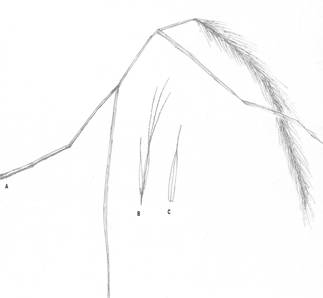 |
| Occurrence: Common along road sides and road cuttings, hill slopes, waste lands, rocky places. |
| Figure 9.2: Aristidia setacea. A. Habit with inflorescence; B. Spikelet; C. Lower glume |
Arthraxon lancifolius (Trin.) Hochst. (Figure 9.3) (Andropogon lancifolius Trin.)
| Annual; culms very slender, trailing, short hairy below flowering branch. Leaves linear to lance shaped or ovate, 1-4 x 0.3-1 cm hairy, margins with short hairs which are bulged at base. Sheaths glabrous. Inflorescence of 2-6 branches, unequal, 0.7-2.5 cm long spikes; joints and pedicels with long hairs or cilia. Spikelets generally stalkless, 2.5-5 mm long, linear-lanceolate, laterally compressed. Lower glume or lemma with two narrow points towards tip and rounded at back; it has no central nerve (keel) and is feebly nerved. Upper glume equals the lower and ends in a narrow point up to 2.5 mm long. It has a bristle or awn, up to 10 mm long from near the base; Stamens 2; Some spikelets may be pedicelled. |
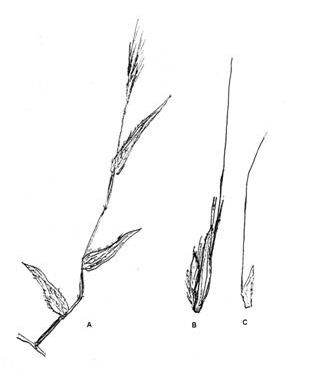 |
| Occurrence: Common along hill slopes, raised bunds, rocky places, and on compound walls, and fences; in moist situation |
| Figure 9.3: Arthraxon lancifolius A. Habit with inflorescence; B. Spikelet; C. Upper glume |
Arundinella leptochloa(Nees ex Steud.) Hook. (Figure 9.4)
(Panicum leptochloa Nees ex Steud; Arundinella gigantia Dalz.; A.lawsonii Hook.)
| Tall perennial; culms up to 2 m, not hairy; root stock hairy.; nodes not hairy. Leaves up to 60 x 3.5 cm, linear-lanceolate, rounded or heart-shaped (cordate) at base. Leaf sheaths striate, poorly hairy with tubercle based hairs; ligule a very narrow membrane. Panicle variable in size, up to 45 x 20 cm. Spikelets 2.5-3.5 mm long, Lower glume 2 mm long, ovate-acute, glabrous except on scabrid nerves. Upper glume not bearded. Lower glume with male of bisexual flower in the axil, broadly elliptic acute, 5-nerved. Upper lemma 1 mm long, bisexual, without awn.) |
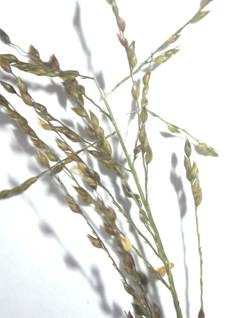 |
Occurrence: Rice field bunds, hill slopes, road cuttings, waste lands etc.; usually in shady places.
Note: Very similar to A.metzii but can be differentiated by its robust and taller growth, purplish flowering branches unawned. |
| Figure 9.4: Arundinella leptochloa- inflorescence |
Arundinella nepalensis Trin. (Figure 9.5), (A.brasiliensis Raddi, A.hispida Blatt.)
| Perennials along stream courses, 1-1.5 m tall; culms stout with hard root stock. Leaves 10-25 x 0.4-1.0 cm, linear lanceolate, hairy. Panicles pyramidal, 10-16 cm long. Spikelets 0.4-0.5 cm long, ovate-laceolate, glabrous; lower glumes to 0.3 cm long, ovate. Upper glume to 0.5 cm long, ovate-lanceolate; lower lemma obtuse, bifid at apex. |
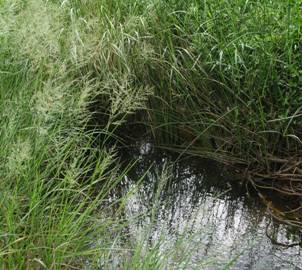 |
| Note: Grows in large population near streams and moist grasslands confused with A.leptochloa but can be distinguished by the large reed-like softly hairy culms below the inflorescence, distinctly awned spikelets. |
| Figure 9.5: Arundinella nepalensis. A. Habit with inflorescence; B. Spikelet; C. Lower glume |
Arundinella metzii Hochst. (Figure 9.6), (A.pygmaea Hook; A.lawii Hook)
| Annual; culms erect, 30-60 cm high, tufted, rounded with striations. Leaves 40 x 0.9 cm, linear, base rounded, softly hairy on both surfaces with tubercle-based hairs, densely ciliate on one margin. Floral panicle up to 50 x 25 cm. Spikelets in pairs, one short and one long pedicelled, 3-4.5 mm long. Lower glume 2-2.5 mm long, lanceolate or elliptic, 3-nerved, Upper glume 2.75 -4.25 mm long, elliptic, narrowing and ending in an abrupt tip. Lower lemma with male and upper lemma with bisexual flowers, 1 mm long, with 3 mm long awn. |
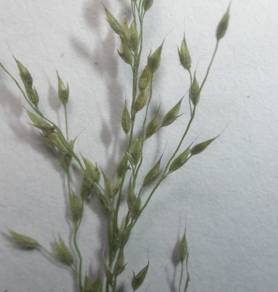 |
| Occurrence: Common in open grassland, cultivated fields, and other moist places. |
| Figure 9.6: Inflorescence of Arundinella metzii |
Brachiaria miliiformis (J.S. ex C.B.Presl) A.Chase (Figure 9.7)
(Panicum miliiforme J.S. ex C.B.Presl)
| Annual to perennial grasses. Culms slender, erect or creeping and rooting at lower nodes, 30-75 cm high. Leaves up to 17 x 1 cm, lanceolate, base cordate; sheaths glabrous, margin ciliate; ligule a fringe of hairs. Panicle consists of 4-6, horizontally spreading racemes up to 6.5 cm long; rachis flattened. Spikelets crowded, arranged on one side of axis, 3.25-3.75 mm long, oblong-ovate, tapering rather abruptly to a short point. Lower glume with margins overlapping at base, 5-7 nerved. |
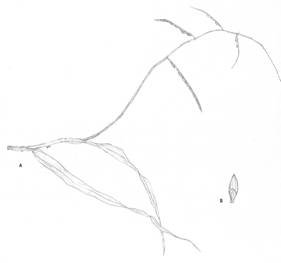 |
| Occurrence: Common along roadsides, waste lands, bunds of paddy field, banks of rivers, usually in shade. |
| Figure 9.7: Brachiaria miliiformis. A. Habit with inflorescence; B. Spikelet |
Centotheca lappacea(L.) Desvaux (Figure 9.8)
(Cenchrus lappaceus L.; Holcus latifolius Osbeck; Centotheca latifolia (Osbeck)Trin.)
| Culms stout erect, 30-100 cm high. Leaves 5-25 x 1-3.5 cm, oblong-lanceolate, acute or acuminate, glabrous or sparsely hairy, many nerved, base narrowed with asymmetrical sides; ligule a lacerate membrane. Panicle up to 30 cm long. Spikelets 4-6 mm long, green, oblong-lanceolate. Glumes distant; lower 2.5-3 mm long, ovate, 3-nerved; Lemmas 7-nerved, lower lemma 4-5 mm long. |
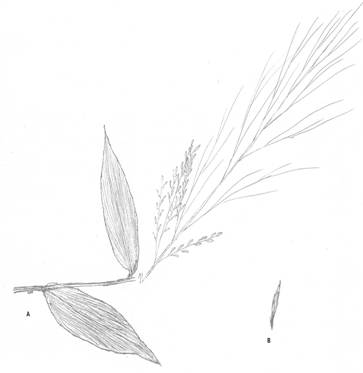 |
| Seen in margins of forests, or in shades of trees and bushes. |
| Figure 9.8: Centotheca lappacea. A. Habit with inflorescence (partly shown); B. Spikelet |
| |
| Chloris barbata Sw. |
| A perennial grass. Culms tufted, up to 90 cm high; nodes glabrous. Leaves 5-30 x 0.2-0.5 cm, flat, linear acuminate, sheaths compressed, junction of sheath and blade hairy. Inflorescence spike type 4-20 in number, each up to 10 cm long. Spikelets green or purplish, each 2.5 mm long; 3-awned; the spikelet axis bearded at base. Glumes translucent, the lower shorter than the upper. Fertile lemma 2-2.5 mm long, obovate concave, back sparsely hairy, margins densely ciliate above the middle, its awn up to 4 mm long. Empty lemmas 2; lower obovate, awned, ciliate above the middle; upper subglobose, awned, glabrous. |
| Occurrence: Very common along roadsides and in disturbed areas; in wetlands; a weed in cultivated fields |
Coelachne simpliciuscula (Wight and Arn. ex Steud.) Munro ex Bth (Figure 9.9)
(Panicum simpliciusculum Wight and Arn. ex Steud.; Ceolachne pulchella sensu Hook.)
| Annuals or perennials, 15-20 cm long, delicate, erect or prostrate with upper parts rising vertical. Leaves 1.0-3.0 x 0.1-0.3 cm, linear-lanceolate, somewhat rough, apex acute. Inflorescence, 2-5 cm long, of short spikes in panicles arranged on the axis with gaps in between. Individual spikelets ovoid, 0.15-0.2 cm long; upper glume suborbicular; lower lemma longer than glumes. |
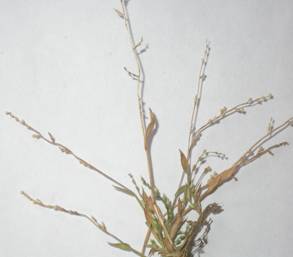 |
| Occurrence: Fairly common in marshes and paddy fields, ditches and other wetlands. |
| Figure 9.9: Coelachne simpliciuscula |
Coix lacryma-jobi L. (Figure 9.10)
| Annual herbs, up to 1.5 m high, erect rooting at lower nodes. Leaves 15-40 x 0.8-1.6 cm, linear-lanceolate. Racemes 1-many with flat axis. Male and female spikelets relatively large; the latter in singles, 1 cm long; male 1.2 cm long. Grains flat, reddish-brown. |
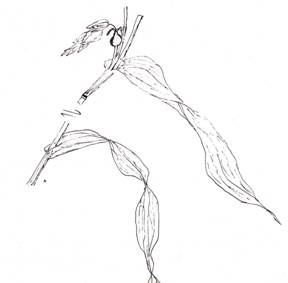 |
| Occurrence: Found growing near wet places and in standing waters. The hardened involucres surrounding female spikelets called, “job’s tears”, used for ornaments |
| Figure 9.10: Coix lacryma-jobi |
Cynodon dactylon (L.) Pers. (Figure 9.11)
(Panicum dactylon L.)
| Weak, creeping perennials, rooting at nodes, with branches rising 5-40 cm into the air; Inflorescence of spikes 1.5-5.5 cm long. Spikelets c 0.2 cm long, stalkless; lemmas silken hairy on keels. |
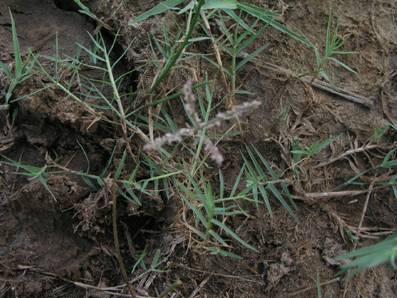 |
| Occurrence: Common grass; Garike in Kannada. |
| Figure 9.11: Cynodon dactylon |
Cymbopogon caesius (Nees ex Hook. & Arn) Stapf (Figure 9.12)
(Andropogon caesius Nees ex Hook; A.schoenanthus var caesius (Nees ex Hook. & Arn.); A. schoenanthus var. gracillimus Hook)
| Perennials. Culms 50-200 cm high. Nodes glabrous. Leaves linear-lanceolate, 10-30 x 0.3-0.8 cm acuminate. Ligules ovate, acute, membranous, 3-5 cm long; Panicles narrow, contracted, 15-40 cm long; joints densely villous. Sessile spikelets linear-oblong, 3-4 x 0.75 mm, callus hairy; keels of lower and upper glumes narrowly winged in the upper half. Palea absent. Pedicelled spikelets elliptic, 3-4 x 1 mm, glabrous; pedicels 1-2 mm long, densely long villous. Stamens 3. |
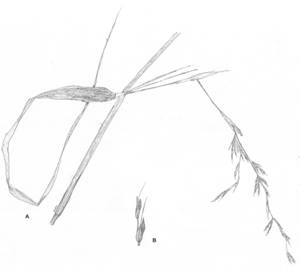 |
| Occurrence: Seen in hill slopes and fringes of forests. |
| Figure 9.12: Cymbopogon caesius. A. Habit with inflorescence (partly shown); B. Spikelet |
Cyrtococcum muricatum (Retz.)Bor (Figure 9.13) (Panicum muricatum Retz.)
| Annuals. Culms 10-75 cm long, creeping or trailing, rooting at lower nodes, rarely upper parts rising; nodes glabrous. Leaves ovate-lanceolate, elliptic or elliptic-lanceolate, 1-10 x 0.4-1.8 cm, acuminate, softly hairy from minute tubercled bases, base conical and fringed with hairs; sheaths also fringed with hairs. Panicles 5-20 cm long lax. Spikelets obovate, 1.5-2 mm, brown or purplish. Lower glume ovate; upper glume boat shaped or ovate-oblong, 3-nerved, softly hairy with a few brown wart like outgrowths. Stamens 3, pale yellow. |
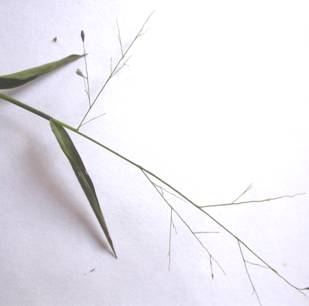 |
| Occurrence: Frequent along shaded margins of forests |
| Figure 9.13: Cyrtococcum muricatum |
Cyrtococcum oxyphyllum (Steud.) Stapf. (Figure 9.14)
| Perennials, ascending; culms slender, 30-60 cm long, rooting below. Panicles 4-6 cm long, branches slender. Spikelets c 0.15 cm long; lower glume elliptic-oblong, brown; upper glume elliptic. |
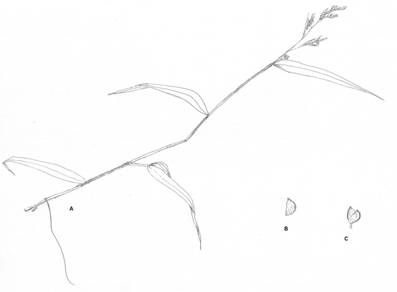 |
| Occurrence: Frequent in forest edges and openings. |
| Figure 9.14: Cyrtococcum oxyphyllum. A. Habit with inflorescence; B. Upper lemma; C. Spikelet |
Cyrtococcum patens (L.) A. Camus (Panicum patens L.)
| Perennials, trailing; culms reclining with upper parts rising, branching, interlaced below, branches erect. Leaves 2.5 -5.0 cm long, linear-lanceolate. Panicles 2.5-4.0 cm long, contracted. Spikelets c 0.15 cm long, elliptic shortly pedicelled, glumes and lemmas dissimilar; lower glume half the length of lemmas, 3-nerved, pale-brown, so also upper one; lower lemma 5-nerved, pale brown, upper naked or bearded at tip. |
| Occurrence: Along forest margins, scrub jungles and moist shady places. |
Dactyloctenium aegyptium . Willd. (Cynosurus aegyptius (L.) Desf.
| Tufted annuals, erect, suberect or geniculately rising, 15-45 cm high. Leaves 2.5 -12.0 x 0.1 -0.5 cm, linear. Spikes 2-6, bearded at base, digitately radiating, 1-4.5 cm long. Spikelets 3- 0.4 cm long. |
| Occurrence: Common in open areas, field bunds. |
Digitaria bicornis (Lamk.) Roem. & Schult ex Loud
(Paspalum bicorne Lamk. Digitaria biformis Willd.)
| Annual with culms up to 80 cm high, ascending from a geniculate or prostrate branched base; nodes glabrous. Leaves 5-15 x 0.4-0.9 cm, linear-lanceolate, glabrous, or sparsely hairy; sheaths glabrous or pilose; ligule a short membrane. Racemes 2-8, from the tip of a short common axis, each up to 15 cm long; raceme axis (rachis?) flat, margins winged. Spikelets in dissimilar pairs, one stalked and the other stalkless. Former glabrous to slightly hairy, the stalked one softly hairy may or may not be pectinate (where?), 2.5 -3.5 mm long, oblong. Lower glume a minute scale. Upper glume fringed with hairs. Lower lemma 5-7 nerved, densely bearded with soft spreading hairs. |
| Occurrence: Very common in open places, as weeds in arecanut gardens. |
Dimeria hohenackeri Hochst. ex miq. (Figures 9.15-9.16)
| A slender annual grass to 60 cm high; nodes bearded. Leaves short, forming a rosette at base, 3-6 x 0.2-0.4 cm, linear-acute, covered with bulbous based hairs, margins hairy; sheaths glabrous in the lower half but pilose in upper half, keeled margins translucent. Racemes 2-9, sub-digitately arranged, up to 12 cm long. Spikelets 3-3.5 mm long, very narrow, compressed, with a short bearded callus. Upper glume not winged, margins translucent, with stiff hairs at apex. Lower lemma margins ciliate at apex. Upper lemma forked at apex and awned from the sinus. |
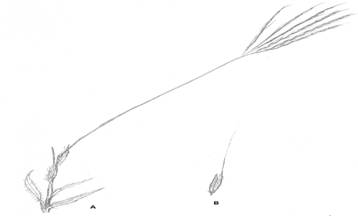 |
| Figure 9.15: Dimeria hohenackeri. A. Habit with inflorescence; B. Spikelet |
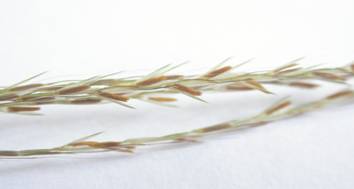 |
| |
Figure 9.16: Inflorescence of Dimeria hohenackeri |
| Occurrence: Common grass in open areas. |
Dimeria ornithopoda Trin. (Figure 9.17) (Dimeria tenera Trin.)
| An annual grass, up to 40 cm high, slender; nodes bearded. Leaves 2-7 x 0.1-0.2 cm, linear-acuminate, covered with bulbous based hairs, especially in midrib and margins, midrib prominent. Racemes 2, rarely 3; erect or spreading rachis triangular in section. Spikelets linear, compressed; callus bearded. Upper glume not keeled, softly hairy, sometimes with stiff hairs towards apex. Upper lemma awned from sinus; awn 4-10 mm long. |
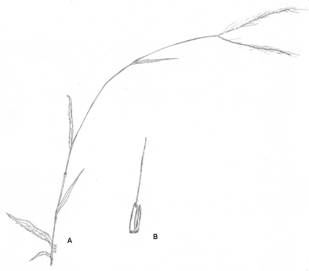 |
| Occurrence: Very common in wet places, uncultivated paddy fields etc. |
| Figure 9.17: Dimeria ornithopoda. A. Habit with inflorescence; B. Spikelet |
Echinochloa colona (L.) Link (Figure 9.18) (Panicum colonum L.)
| Slender annual grass, prostrate to shortly creeping with branches rising to 60 cm. Leaves 5-20 x 0.3 -1 cm, linear-lanceolate; ligule absent. Racemes 8-20, simple, up to 3 cm long; rachis angular. Spikelets ovoid, 2.5-3 mm long with rough hairs. Upper glume as long as lower, ending in sharp point, concave, 5-7-nerved, with rough hairs. Lower lemma broadly ovate or sub-orbicular, 3-nerved. |
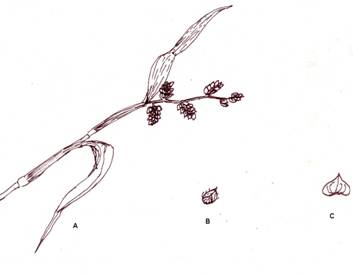 |
| Occurrence: A common weed of paddy fields, and in wet places. |
| Figure 9.18: Echinochloa colona A. Habit with inflorescence; B. Spikelet; C. Upper glume |
Echinochloa crusgalli (L.) P.Beauv.
Panicum crusgalli L.
| An annual grass. Culms tufted, up to 1 m high, nodes glabrous. Leaves 10-50 x 0.6-1.2 cm, linear-lanceolate, acuminate, glabrous; sheaths keeled; ligule absent. Panicle up to 20 cm long; contracted and pyramidal; racemes many. Spikelets 3-4 mm long, subglobose or ovoid, hairy with tubercled based hairs. Upper glume cuspidate or shortly awned, hispidulous. Lower lemma short- or long awned. |
| Occurrence: In wet and marshy areas. |
Eleusine indica (L.) Gaertn.
(Cynosurus indicus L.)
| Culms tufted, 15-75 cm high, erect, slightly compressed. Leaves 8-50 x 0.2-0.6 cm, flat or folded, linear, acuminate, sparsely hairy. Spikes 2-9, up to 14 cm long 5 mm wide. Spikelets 2-5 mm long, 3-6-flowered, closely overlapping in two rows, pointing upwards at an acute angle with the rachis. Upper glume longer than the lower. |
| Occurrence: Very common in damp places. |
Elytrophorus spicatus (Willd.) A. Camus (Figure 9.19)
(Dactylis spicata Willd.; Elytrophorus articulatus P.Beauv.)
Annual herbs, 12-35 cm tall; Leaves 5-17 x 0.15-0.5 cm, linear, acute, smooth. Inflorescence 1.5-3.0 cm long, interrupted spikate. Spikelets 0.5 cm long, ovoid.
Occurrence: In paddy fields and other wet places. |
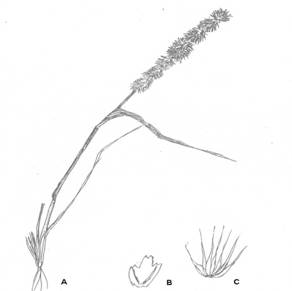 |
| Figure 9.19: Elytrophorus spicatus. A. Habit with inflorescence; B. Palea; C. Spike with awned glumes. |
Eragrostis unioloides (Retz.) Nees ex Steud. (Figure 9.20)
( Poa unioloides Retz.; Eragrostis amabilis Stapf)
| Tufted annual herbs to 25 cm high; culms erect or geniculately ascending. Leaves 3-7 x 0.2-0.4 cm, linear or linear-lanceolate; ligules absent or obscure. Panicles 4-8 cm long. Spikelets 0.2-0.7 cm long, straw colored, tinged with purple. |
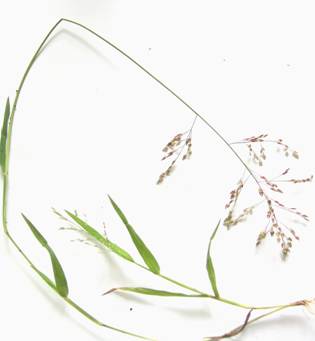 |
| Occurrence: Common in wet places, dry or open |
| Figure 9.20: Eragrostis unioloides |
Eulalia trispicata (Retz.) Nees ex Steud. (Figure 9.21)
(Poa unioloides Retz; Eragrostis amabilis Stapf)
| Stout, tufted perennials, 60-150 cm tall, erect or geniculate. Leaves 10-25 cm long, linear, soft textured; sheaths bearded at sides; ligules short, membranous, fringed with long hairs. Racemes 6-12, 4-6 cm long. Spikelets 0.3-0.4 cm long, elliptic-oblong, densely clothed with white hairs. Upper lemma hardly wider than its awn, bifid into 2 subulate lobes; awn up to 20 mm long. |
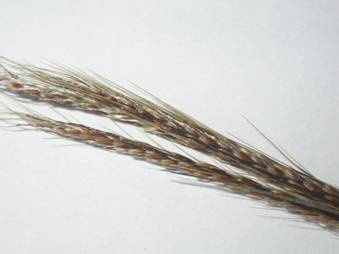 |
| Occurrence: In open grasslands, with some disturbances like repeated fire, digging etc., and in wastelands. |
| Figure 9.21: Inflorescence tip of Eulalia trispicata grass |
Heteropogon contortus (L.) P. Beauv. Ex R. & S. (Figure 9.22)
( Andropogon contortus L.)
| Densely tufted, perennials; culms 10-90 cm tall, creeping below. Leaves 5-14 x 0.2-0.3 cm, linear, acuminate, flat; sheaths compressed. Racemes 3-7.5 cm long. Spikelets closely overlapping. Sessile female spikelets 0.4-0.6 cm long, callus bearded with reddish brown hairs; upper lemma reduced to an awn up to 7.5 cm long or more, awns often twisted about each other. Pedicelled male spikelet c 0.8 cm long. |
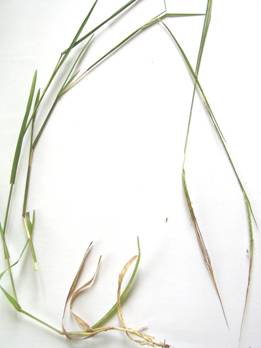 |
| Occurrence: Common on open hill slopes and in waste lands. |
| Figure 9.22: Heteropogon contortus |
Hygroryza aristata (Retz.) Nees ex Wight & Arn (Figure 9.23)
(Pharus aristatus Retz.)
| A floating aquatic grass. Floating culms up to 30 cm long; branches short, erect and leafy. Leaves 2-8 x 0.5-1.8 cm, ovate to ovate-oblong, obtuse, subcordate; sheaths glabrous, inflated, compressed, margin hairy. Panicle up to 5 cm long and broad; branches slender, smooth. Spikelets few, sessile or pedicelled. Lemma 6-8 mm long, narrowly lanceolate; awn up to 14 mm long. |
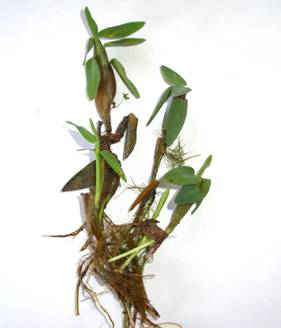 |
| Occurrence: Common in ponds and slow moving streams forming dense floating masses. |
| Figure 9.23: Hygroryza aristata-Habit |
Isachne globosa (Thunb.) Kuntze (Figure 9.24)
Milium globosum Thunb
| A slender grass to 45 cm high, erect or ascending from a creeping base; nodes glabrous. Leaves narrowly lanceolate, 2-10 x 0.4-0.8 cm acuminate, base rounded; ligule a fringe of long hairs. Panicle up to 12 cm long, lax. Spikelets 2-2.5 mm long, subglobose. Glumes subequal, equal to or slightly shorter than lemmas, broadly ovate or suborbicular. Lemmas unequal. |
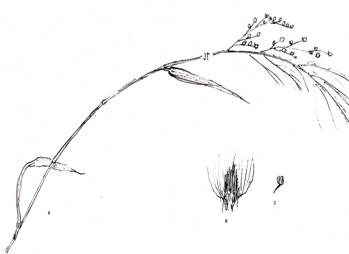 |
| Occurrence: Very common in marshes; a weed in paddy fields. |
| Figure 9.24: Isachne globosa. A. Habit with inflorescence B. Leaf with ligule. C. Spikelet. |
| Isachne miliacea Roth |
| A slender grass to 30 cm high, ascending from a creeping and branched base; nodes glabrous or ciliate. Leaves 2.5-5 x 0.3-0.8 cm, ovate-lanceolate to lanceolate, base rounded; ligule a fringe of hairs. Panicle lax. Spikelets 1.4-1.8 mm long, globose. Glumes subequal, as long as or slightly shorter than lemmas, suborbicular. Lower lemma longer than the upper. |
| Occurrence: Common in marshes; a weed in paddy fields. |
| Ischaemum thomsonianum Stapf |
| Perennial herbs, to 1 m high. Leaves lanceolate, 7-15 x 0.9-1.3 cm, lower leaves sessile. Racemes to5 cm long. Sessile in pairs, one stalked and other stalkless. Lower glume c 0.4 cm long, awned; upper glume oblong, keeled and rounded above, with tufts of hairs in middle. Pedicelled spikelets oblong-lanceolate, 5-6 mm long, awned. |
| Occurrence: Rare along bunds of paddy fields, wet waste lands and banks of rivers. |
Ischaemum dalzellii Stapf ex Bor (Figure 9.25)
| Annuals or perennials. Culms 3-60 cm or more long, creeping or trailing, rarely erect; nodes glabrous or sparsely bearded. Leaves lanceolate or linear lanceolate, 4-15 x 0.8-1.5 cm, long acuminate, deeply cordate or hastate at base, lower ones distinctly petiolate. Racemes 2, slender, 3-6 cm long; joints linear-clavate, 3-4 mm long, densely ciliate along margins. Sessile spikelets linear-oblong 5-6 x 1mm, densely villous in the upper half of the spikelet and glabrous on the lower; awned; callus densely bearded. Pedicelled spikelets oblong-lanceolate, c 6 mm long, awned or awnless. |
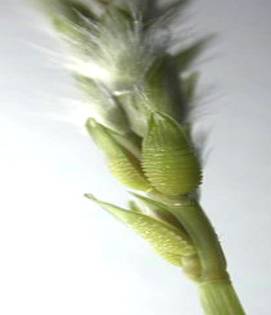 |
| Occurrence: Along rocky hill slopes, shades and near wetlands. |
| Figure 9.25: Inflorescence of Ischaemum dalzellii; note lower glabrous and upper hairy Spikelets |
Ischaemum indicum (Houtt.) Merrill (Figure 9.26)
Phleum indicum Houtt
Ischaemum ciliare Retz
I.aristatum auct. Non L.
| A perennial grass. Culms up to 70 cm high, slender, erect or often creeping at base. Leaves up to 15 x 1.2 cm, linear-lanceolate, sparsely to densely hairy. Sheaths compressed. Racemes 2, rarely 3, up to 8 cm long. Sessile spikelets ovate-oblong, green, reddish or splashed with violet, up to 6 mm long; callus bearded. Lower glume papyraceous towards top, apex 2-toothed or cuspidate, margins inflexed, auricled at base, sides broadly winged at apex, wings often auriculate. Upper lemma bifid with a geniculate awn from sinus; awn up to 12 mm long. Pedicelled spikelets rather smaller than sessile. Upper lemma awned. |
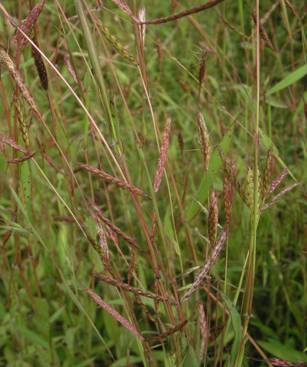 |
| Occurrence: Common grass found in more drier situation such as waste lands, roadsides, common lands, grasslands etc. |
| Figure 9.26: Ischaemum indicum grass |
Ischaemum semisagittatum Roxb. (Figure 9.27, 9.28)
Ischaemum conjugatum Roxb.
| An annual grass. Culms slender, often decumbent at base, than ascending up to 50 cm high or more. Leaves 2.2-9.5 x 0.5-2.0 cm, oblong-lanceolate, base deeply cordate to acutely sagittate. Lower leaves long petioled. Racemes 2, very rarely 1. Sessile spikelets 4-8 mm long. Lower glume ovate or oblong, lower half cartilaginous, with 3-6 marginal nodules, usually connected by irregular and shallow transverse ridges, the upper half with green veins with ciliolate margins, tip usually bifid. Upper lemma 2-fid with a geniculate awn from the sinus, sometimes awnless. Pedicelled spikelet shorter than sessile and almost awnless. |
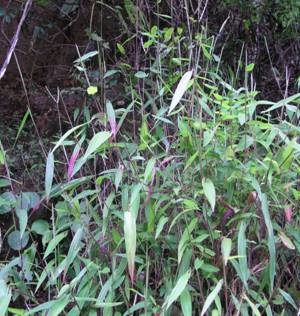 |
| Figure 9.27: Ischaemum semisagittatum |
| Occurrence: Forest openings, edges and other shady places. |
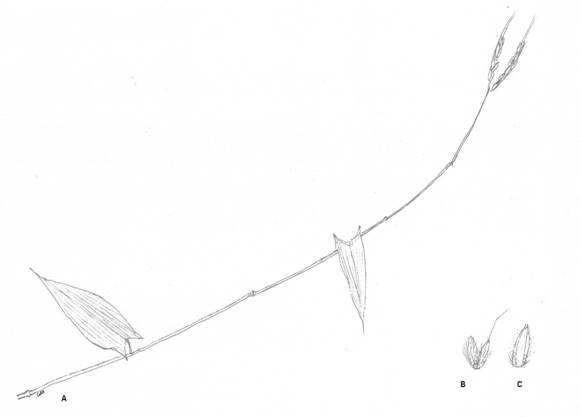 |
| Figure 9.28: Ischaemum semisagittatum. A. Habit with inflorescence; B. Pedicelled and sessile spikelet; C. Lower glume of sessile spikelet. |
Jansenella griffithiana (C.Muell.) Bor (Figure 9.29, 9.30)
Danthonia griffithiana C.
Arundinella avenacea Munro ex Thw.
| Herbs, slender, erect, 15 cm high, rooting at lower nodes. Leaves 2.5-4.5 x 0.4-0.5 cm, ovate-lanceolate; ligules linear. Inflorescence a compact panicle of crowded spikelets. Spikelets subsessile, 4-6 mm long. Upper lemma with 4-5.5 mm long, oblong, with 2 lateral tufts of white hairs above the middle; median awn up to 9 mm long. |
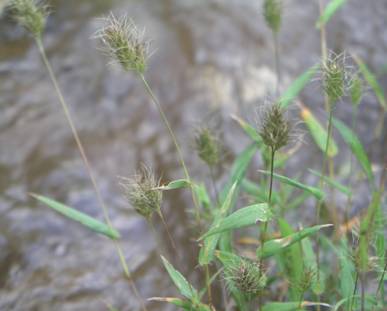 |
| Figure 9.29: Jansenella griffithiana |
| Occurrence: This grass is common in grassy hill slopes, marshy areas and along small irrigation canals. |
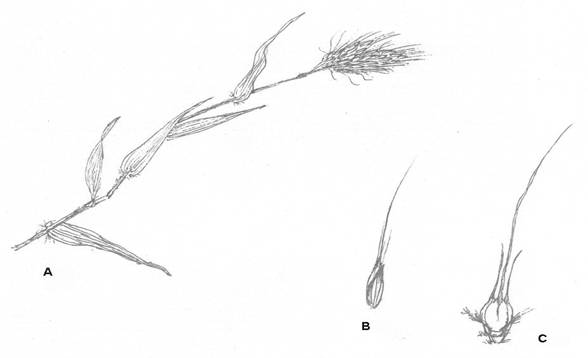 |
| Figure 9.30: Jansenella griffithiana. A. Habit with inflorescence; B. Spikelet; C. upper lemma |
Leersia hexandra Swartz. (Figure 9.31)
Homacenchrus hexandrus (Swartz) O.Kuntze
| A slender, perennial grasses. Culms up to 1.2 m high, geniculate and ascending, rooting at lower nodes; nodes hairy with deflexed hairs. Leaves 7-20 x 0.2-1 cm, linear; ligule a short obliquely truncate or two lobed membrane. Panicle up to 13 cm long. Spikelets ca. 4 mm long. Lemma strongly keeled, keel ciliate. |
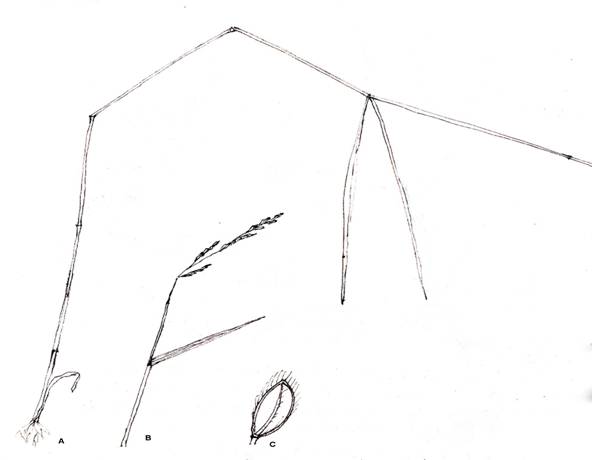 |
| Occurrence: Common in ponds, swamps and in paddy fields. |
| Figure 9.31: Leersia hexandra. A. Habit B. with inflorescence C. Spikelet |
Lepturus radicans (Steud.) A. Camus (Figure 9.32)
Ophiurus radicans Steud.
| A perennial, slender grass. Culms branched and widely creeping below; branches ascending; nodes glabrous. Leaves flat, linear-lanceolate, acuminate, glabrous, 12 x 0.4 cm. Spike 3-5 cm long, 1-flowered. Lower glume absent. |
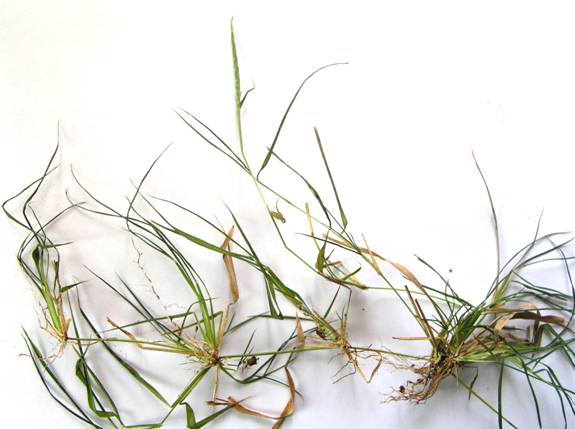 |
| Grasses common as undergrowth in moist to dry deciduous forests. |
| Figure 9.32: Leptuca radicans |
Oplismenus burmannii (Retz.) P.Beauv.
Panicum burmannii Retz. |
| A slender annual grass. Culms slender, creeping and rooting below. Panicle up to 10 cm long; peduncle very long, up to 1.8 cm long. Spikelets up to 2.5 mm long, second. Lower glume ovate, awned, barbellate. Upper glume awned. Lower lemma shortly awned, ciliate. |
| Occurrence: Common undergrowth in semievergreen to deciduous forests, and other open areas. |
Oplismenus compositus (L.) P.Beauv. (Figure 9.33)
Panicum compositum L.
| A perennial grass. Culms rather robust, creeping and rooting below; branches ascending. Leaves 2-16 x 0.5-2.5 cm, ovate to ovate-lanceolate, acuminate; sheaths with ciliate margins. Panicles up to 30 cm long, racemes distant, up to 7.5 cm long; rachis angular. Spikelets, lanceolate, awned; awn to 11 mm long, stout and viscid. Upper glume mucronate or shortly awned. |
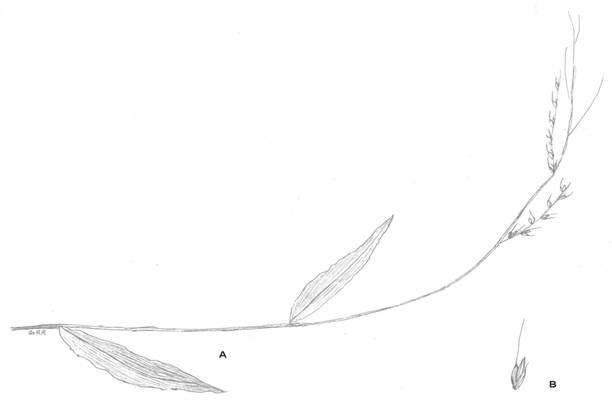 |
| Occurrence: Common in open shady places. |
| Figure 9.33: Oplismenus compositus. A. Habit with inflorescence (partly shown); B. Spikelet |
| Oryza rufipogon Griff. |
| An aquatic grasses. Culms rooting in mud and the floating branches up to 80 cm long. Leaves up to 50 x 1.1 cm, linear-lanceolate, acuminate, striated; ligule long membranous, 2-partite. Panicle compound, up to 25 cm long. Spikelets ca. 9 mm long, oblong, long awned. Fertile lemma dorsally spinescently ciliate. |
| Occurrence: Seen in ponds, paddy fields and other small water bodies. |
Panicum auritum Presl. (Figure 9.34)v
| A perennial, tall, erect grass. Culms up to 1.5 m high. Leaves linear-lanceolate, up to 35 x 3 cm, base broadly cordate; sheaths glabrous or sparsely hairy with bearded mouth. Panicle contracted or more or less open, up to 45 cm long. Spikelets 2-3 mm long, oblong or ovate-oblong, sessile or shortly pedicelled. Lower glume broadly ovate, one third to half the length of lower lemma, 3-nerved. |
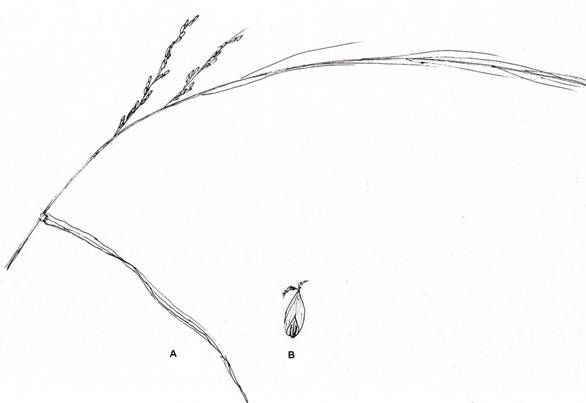 |
| Occurrence: Found in marshy areas. |
| Figure 9.34: Panicum auritum Presl. A. Habit with inflorescence B. Spikelet |
Panicum repens L. (Figure 9.35)
| A perennial grass. Culms creeping and stoloniferous at base, up to 1.3 m high; nodes glabrous, lower nodes rooting. Leaves distichous, glacous, lanceolate, 5-25 x 0.2-0.8 cm, margin finely serrate, glabrous or hairy on upper surface, base rounded and ciliate; sheaths with ciliate margins; ligule a short thin membrane with a very short cilia on free margin. Panicle up to 20 cm long. Spikelets oblong-lanceolate, 2-5-3.3 mm long, glabrous; pedicels long with copular tips. Lower glume suborbicular, hyaline. |
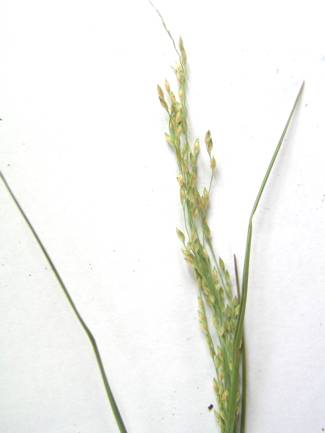 |
| Occurrence: Common in sandy soils, field bunds and tank margins. |
| Figure 9.35: Inflorescence of Panicum repens grass |
Paspalidium flavidum (Retz.)A. Camus
Panicum flavidum Retz. |
| Annual with tufted culms, rising from a reclining base, up to 1 m high. Leaves 2.5-20 x 0.2-1 cm, flat, linear-lanceolate, base rounded or slightly cordate with long white hairs on the small basal lobes; sheaths compressed, ligule a fringe of hairs. Racemes few to many, distant, one sided on the axis, shorter than internodes, up to 3 cm long. Spikelets 2.5-3.2 mm long, ovoid or subglobose, obtuse or acute, hardly compressed. Lower glume suborbicular, about half the length of the spikelet. |
| Occurrence: Common in wet situations. |
| Paspalum conjugatum Berg |
| A perennial grass. Culms up to 90 cm high, creeping and branching below. Leaves up to 20 x 1.5 cm, linear-lanceolate, acuminate; sheaths glabrous, margins ciliate. Racemes 2, up to 15 cm long, usually divergent; rachis flat. Spikelets in two rows, subsessile, imbricate, plano-convex, 1.4-2 mm long. Lower glume absent. Upper glume hyaline, fringed with fine white hairs from margins. |
| Occurrence: Grows in moist and shady situation. |
Paspalum canarae (Steud.) Veldkamp (Figure 9.36)
Paspalum compactum Roth.
| Annual slender grasses. Culms 5-30 cm tall. Decumbent and branched below. Leaves 1.5-7.5 x 0.5-1.6 cm, elliptic-lanceolate, acute, hairy on both sides; sheaths densely covered with bulbous based hairs. Racemes 6-many, alternate, spreading; rachis triquetrous, setose. Spikelets closely arranged up to 1.25 mm long, obtuse. Lower glume absent. |
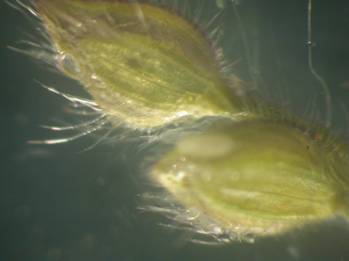 |
| Occurrence: In open grasslands and in wet situation. |
| Figure 9.36: Paspalum canarae; setose spikelets. |
Paspalum scrobiculatum L. (Figure 9.37)
P.orbiculare Forst.
P.commersonii Lamk.
P.cartilagineum J.S.Presl ex. C.B.Presl.
| An annual or a perennial grass. Culms up to 90 cm high, tufted, erect or creeping and rooting below; nodes glabrous. Leaves 10-45 x 0.2-0.8 cm, linear-lanceolate, acuminate, margin serrulate, glabrous; leaf sheaths, compressed, glabrous, keeled. Racemes 2-6, alternating, spreading, 2-15 cm long; rachis, broad, winged, with a median keel. Spikelets in 2-rows, orbicular or ovate-oblong, 1.8-2.8 mm long. Lower glume absent. Upper glume 5-nerved. |
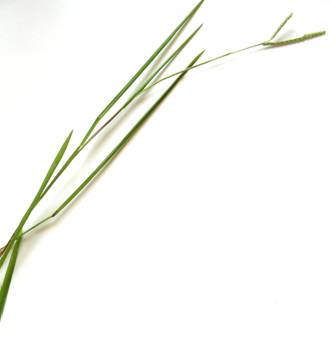 |
| Occurrence: Common in wet and waste places. |
| Figure 9.37: Paspalum scrobiculatum |
Pennisetum hohoenackeri Hochst. ex Steud (Figure 9.38)
P.alopecuros Nees ex Steud
| Perennials. Culms 30-150 cm high, erect, densely tufted; nodes glabrous. Leaves narrowly linear, acuminate, 10-60 x 0.2-0.8 cm narrow or rounded at base, convolute, glaucous. Sheaths keeled, distichous. Panicles spiciform, 5-25 cm long, involucre enclosing one sessile spikelet, bristles glabrous or scaberulous, 3-20 cm long. Spikelet elliptic-lanceolate or lanceolate, 6-8 mm long. Lower glume ovate. Upper glume ovate-lanceolate, 5-7 nerved. |
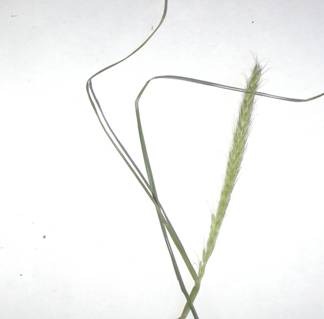 |
| Occasional along the banks of streams and other water-courses, paddy field bunds and on river beds etc. |
| Figure 9.38: Pennisetum hohoenackeri grass |
Pennisetum pedicellatum Trin. (Figure 9.39)
| An annual grass. Culms up to 1 m high, branched from base. Leaves flat, up to 35 x 1.5 cm; sheaths glabrous. Panicle up to 20 cm long; involucres sessile; outer bristles few, inner bristles numerous, longest up to 16 mm long; densely villous below middle. Spikelet solitary and pedicelled, or in groups of 2-5, with one sessile and other pedicelled, or in groups of 2-5, with 1 sessile and other pedicelled, up to 4.25 mm long. Lower glume very small, wooly. |
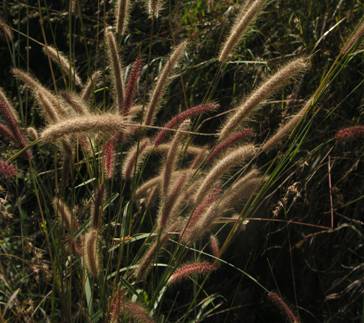 |
| Occurrence: Seen in hill slope grasslands, roadsides etc. |
| Figure 9.39: Inflorescence of Pennisetum pedicellatum grass |
Pseudanthistiria umbellata (Hack.) Hook (Figure 9.40)
Andropogon umbellatus Hack.
| A very slender grass. Culms very weak, straggling, creeping and rooting at nodes. Leaves up to 6 x 0.75 cm, lanceolate, glabrous on both sides, rounded at base, primary and secondary nerves indistinguishable; sheaths shorter than blade. Panicle leafy, very lax, interrupted, 12-20 cm long; fascicles of spikelets few, axillary, 6-12 mm wide, raceme 3-6 in a fascicle; proper spathes 8-15 mm long, margins finely ciliate from minute tubercles. Sessile spikelets 3.5-4.5 mm long; lower glume 7-nerved. Awn up to 20 mm long. Pedicelled spikelets lanceolate, 4-6 mm long. |
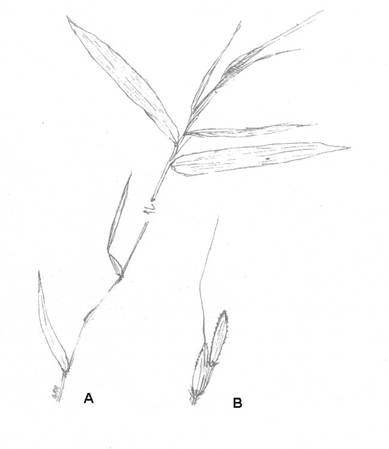 |
| Occurrence: Common in shady places. |
| Figure 9.40: Pseudanthistiria umbellata. A. Habit with inflorescence (partly shown); B. Spikelet |
| Pseudanthistiria hispida Hook. |
| Annuals. Culms 30-100 cm high, tufted, nodes glabrous. Leaves lanceolate or linear-lanceolate 5-20 x 0.2-0.8 cm, acuminate, rounded at base. Panicles oblong, 2-3 mm long, awned. Lower glume oblong or elliptic-oblong, 2-3 mm long. Upper glume linear-oblong, upper lemma awn up to 3 cm long. Pedicelled spikelets lanceolate, sparsely setose at apex. 0-25 cm long, |
| Occurrence: Seen in hill slope grassland. |
Pseudanthistiria heteroclita (Roxb.) Hook. (Figure 9.41)
Anthistiria heteroclita Roxb.
| Annuals, culms up to 70 cm high, erect or geniculate at base. Leaves linear, 15-30 x 0.3-0.5 cm, more or less hairy from tubercles on both sides. Panicles 20-30 cm long, leafy, compound with many shortly peduncled fascicles; proper spathes 7-10 mm long, margin setose, usually from minute tubercles; racemes 6-8 mm long. Sessile spikelets 3-4 mm long, linear-oblong, hispid. Upper glume as long as the lower; upper lemma awn up to 20 mm long. Pedicelled spikelets 2.5-3 mm long. |
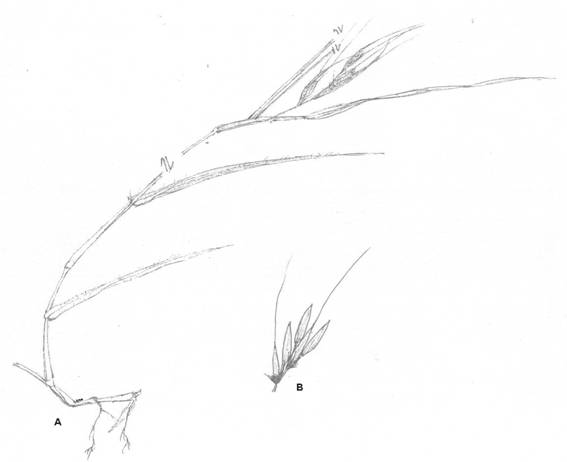 |
| Occurrence: Occasional in grassy hill slopes, open grasslands etc. |
| Figure 9.41: Pseudanthistiria heteroclita. A. Habit with inflorescence (partly shown); B. Raceme with lower pair of sessile and pedicelled spikelet, and upper group of 3 spikelets with 1 sessile awned and 2 pedicelled unawned spikelets |
Sacciolepis indica (L.) A. Chase (Figure 9.42)
Panicum indicum Mill
Panicum indicum L.
| A slender grass. Culms erect, up to 60 cm high. Leaves 2.5-15 x 0.2-0.5 cm, linear. Panicle 1-14 cm long, continuous, cylindric, spiciform; branches very short. Spikelets ovate-lanceolate, acute, usually curved, 2.5-3.5 mm long. Lower glume half as long as spikelet. Upper glume 7-9 nerved. |
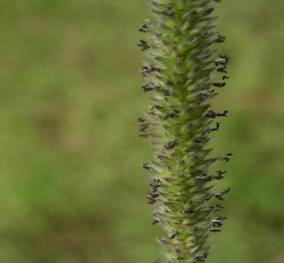 |
| Occurrence: Very common in marshes and as a weed in paddy fields. |
| Figure 9.42: Inflorescence of Sacciolepis indica grass |
Sacciolepis interrupta (Willd.)Stapf. (Figure 9.43)
Panicum interruptum Willd.
| A large, perennial aquatic grass. Culms up to 1.8 m high, stout and spongy below, ascending from a creeping and rooting or floating root stock. Leaves 15-35 x 0.5-1.3 cm, linear, acuminate, base rounded or subcordate. Panicle 10-30 cm long, cylindric, interrupted below. Spikelets 4-5 mm long, ovoid-lanceolate, subsessile or shortly pedicelled. Lower glume hyaline, less than half the length of spikelet, broadly ovate. Upper glume 9-nerve |
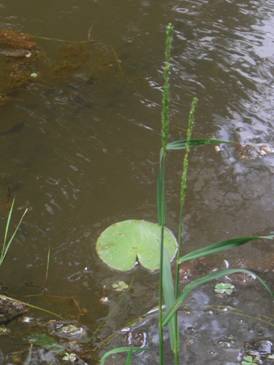 |
| Occurrence: This grass is frequent in swampy situations. |
| Figure 9.43: Habit of Sacciolepis interrupta grass |
Setaria pumila (Poir.) Roem. & Schult (Figure 9.44)
Panicum pumilum Poir.
Setaria pallide-fusca (Schumach.) Stapf & C. E. Hubb.
Panicum pallide-fuscum Schumach.
| An annual grass. Culms tufted, simple or branched, erect or ascending, up to 1 m high. Leaves 6-32 x 0.3-1 cm, linear-lanceolate, base rounded; ligule a ridge of hairs. Panicle cylindric, continuous, sometimes almost capitate with few spikelets, up to 16 cm long., Involucral bristles 6-12, usually yellow, rarely reddish-brown, up to 9 mm long, antorsely barbed. Spikelets ca. 2.25 mm long, ellipsoid. Lower glume less than half the length of the lower lemma, broadly ovate, hyaline. Upper lemma dorsally gently curved. |
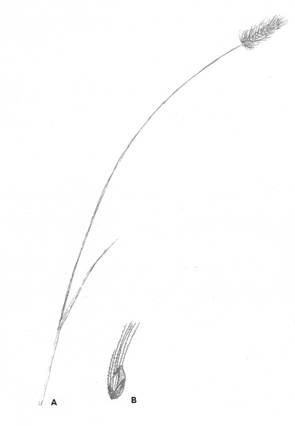 |
| Occurrence: Seen in wetlands, bunds of paddy fields, roadsides, along the margin of forest, open grassland and waste places. |
| Figure 9.44: Setaria pumilla. A. Habit with inflorescence; B. Spikelet |
Spodiopogon rhizophorus(Steud.) Pilger (Figure 9.45)
Andropogon rhizophorus Steud.
Spodiopogon albidus Benth.
| Annuals or perennial straggling grass. Culms tufted, much branched, rooted at lower nodes, up to 1.25 m tall. Leaves flat, up to 25 x 3 cm, oblong-lanceolate, acuminate, base narrowed into a slender petiole up to 8 cm long; sheaths glabrous, ligule oblong. Panicle at first enclosed in a long spathaceous sheath; rachis and pedicels compressed, ciliate. Spikelets up to 10 mm long, lanceolate, densely covered with white hairs. Lower glume 7-9 mm long, ovate-lanceolate, minutely 2-mucronate or aristate, densely ciliate. Upper lemma 5-7 mm long, its palea broad, awn up to 2.5 cm long. |
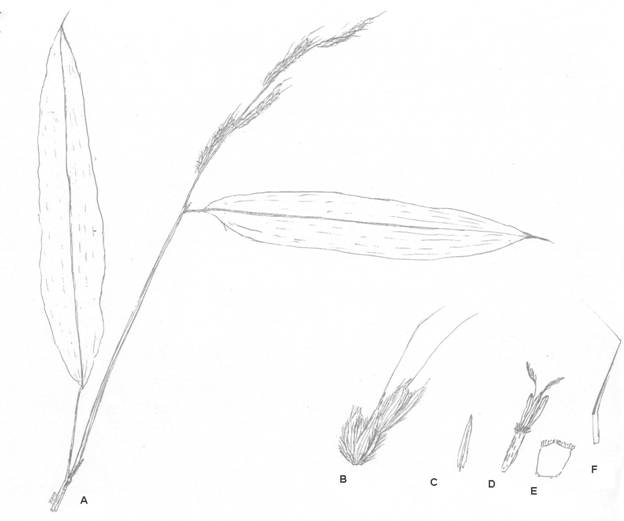 |
| Occurrence: Occasional on old fort walls and on road cuts in Ghats. |
| Figure 9.45: Spodiopogon rhizophorus. A. Habit with inflorescence; B. Sessile and pedicelled Spikelet; C. Anther; D. Palea enclosing nut and anther; E. Palea opened; F. Upper lemma |
Themeda tremula (Nees ex. Steud.) Hack. (Figure 9.46)
Anthistiria tremula Nees ex Steud.
| A perennial grass. Culms erect or ascending from a creeping root stock, up to 1.25 m high, leafy, smooth, brown. Leaves up to 50 x 1.4 cm, finely acuminate, rigid, suberect, glabrous or nearly so, margins scabrid; sheaths compressed. Panicle 30-60 cm long, racemiform; fascicles of racemes rather subflabelliform, 1-3.5 cm wide, on flexuous capillary peduncles; outer spathes 1-3.5 cm long, more or less hairy with simple or tubercle based hairs; proper spathes 1-2 cm long, compressed, finely setose from large tubercles, margins scarious. Involucral pairs in superposed pairs, up to 8 mm long. Lower glume 6.5-8 mm long, linear-lanceolate. Pedicelled spikelets lanceolate, smaller than involucral spikelets and similar to them. Bisexual spikelets 2, sessile, bearded with reddish hairs. Upper lemma with awn up to 3 cm long. |
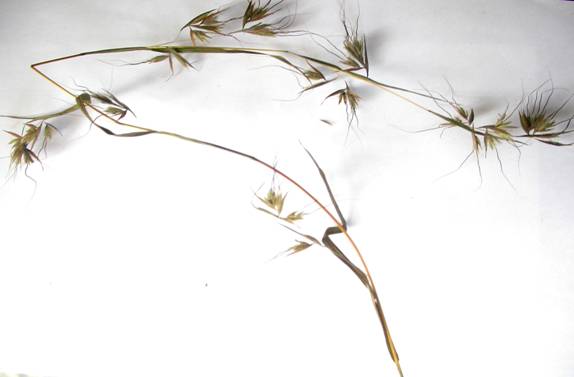 |
| Occurrence: In open grassland, hill slopes, road cuttings etc. |
| Figure 9.46: Themeda tremula Presl. A. Habit with inflorescence |
|














































